Hi all,
I have a gunite pool, 2.5 years old, that is showing evidence of stress cracks in the bond beam/waterline tile, and extending down into the pebbletec and gunite below. Currently two cracks, the newer one being larger and more concerning. First two pix are the smaller original crack, coming off of a pier at the back wall of the pool. That crack extends down into the pebbletec about 3 feet or so, but is a hairline crack from the waterline down. The pebbletec is very slightly discolored down the length of the crack. The other pix are the larger crack at the front coping, which is pretty large (1/8" wide) at the top, and gets narrower as you go down into the pebbletec. The pebbletec here is cracked 18" down, turns a radiused corner, and goes another 18" on the floor of the pool itself before it disappears.
My questions are: how much of a problem is this, aside from the cosmetic issue?
Aside from repairing the grout at the joints of the waterline tile and the coping, how are cracks in pebbletec repaired; is pebbletec repairable while immersed in water, or does the pool level need to be lowered to repair/fill the cracks?
The pool rebar was done correctly, at 6" on center for the full floor and walls. But we have extremely expansive soil in this part of Phoenix, so although the rebar was done with belt and suspenders, there was always a chance this type of ground movement could cause a crack. Now I just need to get smart on how to address the repair of these cracks.
Water loss is being measured, I'm in day two of a bucket test, and so far things are not encouraging. First 24 hours: bucket down 5/16", pool down 11/16", so 3/8" more than the bucket. Second 24 hours: bucket down 5/8", pool down 1 7/16", so about 3/4" more than the bucket.
Is it really possible that these cracks are causing me to lose over 160 gallons per day? I guess you don't need to be Einstein to conclude that the answer is "yes". But if anyone could confirm that cracks of this size could really leak that much water, I'd appreciate the insight.
Thanks,
Jim K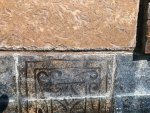
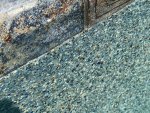
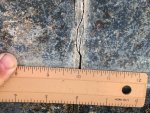
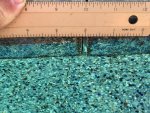
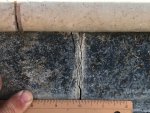
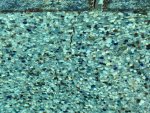
I have a gunite pool, 2.5 years old, that is showing evidence of stress cracks in the bond beam/waterline tile, and extending down into the pebbletec and gunite below. Currently two cracks, the newer one being larger and more concerning. First two pix are the smaller original crack, coming off of a pier at the back wall of the pool. That crack extends down into the pebbletec about 3 feet or so, but is a hairline crack from the waterline down. The pebbletec is very slightly discolored down the length of the crack. The other pix are the larger crack at the front coping, which is pretty large (1/8" wide) at the top, and gets narrower as you go down into the pebbletec. The pebbletec here is cracked 18" down, turns a radiused corner, and goes another 18" on the floor of the pool itself before it disappears.
My questions are: how much of a problem is this, aside from the cosmetic issue?
Aside from repairing the grout at the joints of the waterline tile and the coping, how are cracks in pebbletec repaired; is pebbletec repairable while immersed in water, or does the pool level need to be lowered to repair/fill the cracks?
The pool rebar was done correctly, at 6" on center for the full floor and walls. But we have extremely expansive soil in this part of Phoenix, so although the rebar was done with belt and suspenders, there was always a chance this type of ground movement could cause a crack. Now I just need to get smart on how to address the repair of these cracks.
Water loss is being measured, I'm in day two of a bucket test, and so far things are not encouraging. First 24 hours: bucket down 5/16", pool down 11/16", so 3/8" more than the bucket. Second 24 hours: bucket down 5/8", pool down 1 7/16", so about 3/4" more than the bucket.
Is it really possible that these cracks are causing me to lose over 160 gallons per day? I guess you don't need to be Einstein to conclude that the answer is "yes". But if anyone could confirm that cracks of this size could really leak that much water, I'd appreciate the insight.
Thanks,
Jim K










